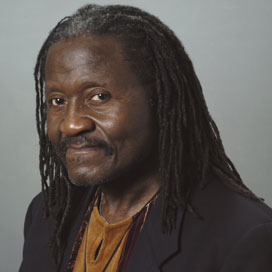INTUIT / ŌĆ£Crian├¦a Das OndasŌĆØ
The first time I heard Intuit’s "Criança Das Ondas," I loved it. Right there in the intro, the tune mixes a rumbling bassline with heavy funk drums playing an Afro Beat-like cadence. Then over that, they throw in the piercing wail of the Brazilian cu├Łca. But around two minutes in, the tune settles into a smooth mid-tempo feel and, wouldn’t you know it, my man Airto Moreira comes in singing. Not long after that we get to the first chorus and Airto is joined by his wife Flora Purim (a legend of Brazilian music in her own right) and Airto and Flora’s daughter, Diana Booker (n├®e Moreira). Finally, a horn section swings in and the entire presentation—which was already threatening to take flight—absolutely soars. It was a real ‘wow’ moment for me and some of the hippest Seventies-style Afro-Brazilian music I’d heard in a long time. The catch is, "Criança Das Ondas" is from Intuit, an album released in 2004; and, the cats who wrote and produced the music aren’t from Brazil or anywhere else in South America or the Caribbean, they’re from Germany.

The two Germans, Thomas Braun (drummer and percussionist) and Till Maragnoli (bassist) didn’t plan any of this. As recently as ten years ago, Maragnoli was playing bass in a reggae band and Braun was playing in a different band while trying to make a name for himself as a producer. Once they met, they discovered they shared an affinity for the glory days of black music: the Seventies. Braun—the studio junkie—is the perfectionist; Marignoli—with his vinyl collection of 20,000-plus—is the music man. Together, they make no real distinction between genres or styles of music. Listen to their debut album and you’ll find that hi-life, funk, soul, samba, MPB, jazz and modern club sounds are all in there waiting.
European producers using machines and computers to create black music hybrids is nothing new, but Intuit distinguishes themselves by doing their thing without that subtle undertone of kitsch that pervades many similar attempts. Although every track uses programmed loops, for most of the album it’s almost impossible for the listener to tell. Due to Braun and Maragnoli’s use of so many layers of traditional instruments atop those sampled drum rhythms, Intuit’s overall sound is very full and organic. A lot of the credit has to go to the Intuit duo themselves—they composed all of these old-sounding tracks except one, Andy Bey’s cover of the jazz near-standard “Western Sunrise.”
Of course, a lot of the credit for the band’s vibrant sound also has to go to the capability of the musicians playing those traditional instruments. The line-up Intuit uses for their album reads like the album credits to a long-lost ‘Seventies Super Session’ of progressive jazz fusion. In addition to Airto and Flora, the album features work from Black Jazz composer and pianist Doug Carn, former Horace Silver vocalist Andy Bey and Herbie Hancock alumnus Ray Obiedo. (By the way, “Western Eyes” is a Doug Carn composition.)
At times, Braun and Maragnoli are like a music-minded Penn & Teller: they not only let you see how the trick is done, but once you can clearly hear the machinations behind the magic, you’re even more impressed, not less. For example, 3:40 into the Afro-Beat stomper “Fenytola” (that’s Carn on the Hammond B3) the horns, guitar and keyboards drop out, leaving just the groove. As the break plays, you can suddenly tell that the intricate and soulful drumming you’ve been listening to is actually a programmed loop. Ditto for the tail end of both Brazilian songs "Criança Das Ondas" and “O Preguiçoso.” If someone had told me those tracks were loops rather than ‘real’ drums without letting me actually hear the evidence, I wouldn’t have believed it.
The ending of “Criança Das Ondas” is particularly revealing because Braun and Maragnoli rather impudently fade the instruments and voices rather than dropping them out naturally. It’s like looking at yourself in a mirror and watching your skin, hair and muscle melt, leaving nothing but a startlingly shiny metal skeleton. Of course the ‘perfect’ appearance (or sound, as it were) of that skeleton hides a lot. Braun creates his rhythm tracks by beating on old drum skins and then recording the sounds with intentionally cheap microphones. He then manipulates the samples until he finds a pattern he likes. “Our intention,” Braun says, “is to deliver a sound that seems to come freshly out of the studio, although we sometimes fiddle about with one bar [for] months.”
In case you’re wondering how two relatively unknown producers from a town in South Germany convinced all of these legends of American and Brazilian music to join them in the recording studio, I was wondering the same thing. Until it occurred to me that Braun and Maragnoli probably just called them up and asked. And, if you want to get technical about it, the musicians didn’t all ‘join’ each other anywhere. The drum tracks, basslines and most of the horns were done in Germany.

Doug Carn’s keyboards were recorded in Savannah, Georgia.

Airto and Flora did their thing in Los Angeles.

Ray Obiedo recorded his guitar parts and other background vocals in his studio in the Bay Area.

In the liner notes, the band thanks Andy Bey for “magic moments in our studio,” so apparently, Bey recorded his vocals the old-fashioned way: on location.
If it still seems odd that such renowned artists would agree to appear on an debut album to be released on a German boutique label, think about this: the music industry is notorious for blacklisting, stonewalling and otherwise ignoring so-called ‘has beens.’ You may be extraordinarily talented and accomplished, you may have an impressive catalog, and most importantly, you may still have a lot to say musically, but if you aren’t sellable, most record companies simply aren’t interested. On their debut album, Braun and Maragnoli prove that creating high quality and very enjoyable music need not depend on if the musician is or ever was in the limelight. Instead, it’s all about the music.
—Mtume ya Salaam
The german soul movement
OK. Everybody knows Germans are known for their technical precision. Applied to music production we get this kind of android soul music, except that it’s not really a hybrid because it’s simply human music produced using digital technology.
You know that whole Memorex test question? Well, these guys raise the question to irrelevancy—not only can’t you tell what’s live human-produced and what’s studio computer produced, it really doesn’t matter in terms of the final outcome.
That said, I like Intuit, their homage to seventies soul and jazz, their featuring of the creators from back in the day, almost like the Intuit technique is a time machine mash-up: you get the old folk to do what they did when they were young, you sample sounds from years before to craft your current output. No doubt this is some good shit.
Regardless of how you feel about Euro-centric contributions to Afro-centric sounds, you’ve got to admit nobody would mistakenly classify this as techno or electronica, although that’s precisely what it is at the production level.
Me myself, I think Intuit (and other aggregations like them) prove the point that Black music is now world music, not simply as a marketing term (i.e. “world music”) but rather as the major force shaping music produced any and everywhere in the world.
Of this type of music my favorite is Les Gammas (DJ and drummer Marc Frank and vocalist and pianist Jochen Helfert) who, not un-coincidentally, are a duo from Germany (Augsburg), and who are also on the Munich, Germany-based Compost label, and who also have their debut solo album (Exercices des Styles) out after a number of singles and remix projects.
The biggest difference between Intuit and Les Gammas is that Jochen Helfert is the lead vocalist for Les Gammas rather than one of the many guest vocalists who adorn Intuit’s work. That’s a significant difference. Although my main Jochen is no Al Green, on the flip side he’s not Pat Boone or even Justin Timberlake. Check Jochen on their cover of the American songbook standard “All Of Me” and on “Don’t Waste My Love.”
Plus, Les Gammas write in a cinematic style: each composition has sections swinging deliciously between flat-out funky rhythms on the upside to electronic textures and symphonic strings on the down-tempo, all occurring within one song. “Afternoon At Rossi’s” is a sterling example of the Les Gammas stylistic mash-up approach. Even their rhythm-driven pieces, such as “Whenever,” shift gears.
These cats are not great innovators as players, their forte is composition. The difference is that their compositional talents are now focused on Black music traditions rather than the classical music traditions of Europe. We welcome their additions and contributions.
—Kalamu ya Salaam
This entry was posted on Sunday, January 28th, 2007 at 12:52 am and is filed under Contemporary. You can follow any responses to this entry through the RSS 2.0 feed. You can leave a response, or trackback from your own site.
3 Responses to “INTUIT / ŌĆ£Crian├¦a Das OndasŌĆØ”
January 28th, 2007 at 4:16 pm
I’m so shocked! I always listen to the jukebox first, then read the conversation just so that I can truly enjoy the samplings you’ve set on our table. Who knew that most of this slammin’ Brazilian music was "canned?!" I am a dancer, and usually we can tell when it’s out of the box rather than off the skin because it becomes too even for hips to deal with the line (think ellipses trying to roll as quickly as an arrow flying). In any event, thank you once again for dispelling myths and challenging us to think about blackness as a process, rather than a product.
August 30th, 2014 at 6:38 am
Wow that was unusual. I just wrote an incredibly long comment but after I clicked submit my comment didn’t appear.
Grrrr… well I’m not writing all that over again. Anyway, just wanted
to say superb blog!
October 31st, 2014 at 12:39 am
I tend not to leave a comment, but I read a few of the
responses on this page breath of life ╗ INTUIT / ŌĆ£Crian├¦a Das OndasŌĆØ.
I actually do have a few questions for you if it’s okay. Could
it be just me or do a few of the responses come across as
if they are left by brain dead visitors? ¤śø And, if you
are writing at additional online social sites,
I would like to keep up with anything new you have to post.
Could you make a list of the complete urls of your shared pages like your
twitter feed, Facebook page or linkedin profile?
Leave a Reply
| top |